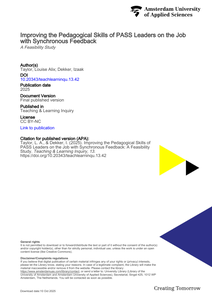Several bachelor courses of Inholland University of Applied Sciences experimented with the possibilities of the online synchronous classroom. Two platforms were used; Zoom video conferencing and Barco Virtual Classroom. As research group, we conducted exploratory observations as this experimentation unfolded during several of these sessions. Interviews were held with some teaching and technical staff. Organisational, technical and pedagogical factors regarding the delivering of flexible education were examined. During the observations of this emergent practice, some patterns became visible. This report contains a first description of the seven phases when initiating the online classroom.
DOCUMENT

Peer assisted study sessions (PASS), also known as Supplemental instruction, are structured peer guided sessions linked to a specific course, led by experienced and trained students called PASS-leaders. These PASS-leaders undergo several days of training before running their first session and receive supervision and feedback ‘on the job’. Research suggests that training improves student outcomes whereby supervision is considered best practice, as required by PASS protocols. However, it is unclear what type of supervision best supports PASS-leaders. Thus far, studies have not compared different methods for on-the-job interventions. Current practice involves supervisors observing PASS sessions without intervening but providing post hoc feedback. While this prevents undermining the PASS leaders, it delays their ability to act on feedback immediately. This study, carried out at an institution for initial teacher education, developed and tested a method for providing immediate feedback using a bug-in-ear device linked to a live-stream. Six PASS-leaders were observed during 4-6 sessions each, receiving either synchronous feedback with a bug-in-ear or in-person asynchronous post hoc feedback. In group interviews PASS-leaders reported appreciating the immediacy of synchronous feedback which allowed them to act on it in real-time. The surveys after each lesson indicated that they felt significantly more confident about teaching following live feedback. They described the supervisor as an invisible helper, providing support or assistance. Because the bug-in-ear method could only provide feedback on visible instructional and pedagogical actions, both PASS-leaders and PASS-supervisors recommended using this as a supplement to a pre-session briefing and a post-session debrief.
DOCUMENT

As multimedia gradually becomes more and more an integrated part of video conferencing systems, the use of multimedia integrated desktop video conferencing technology (MIDVCT) will open up new educational possibilities for synchronous learning. However, the possibilities and limitations of this technology must be clearly understood so that it can be used to maximize possible pedagogical benefits and reduce possible pedagogical limitations. This paper analyses the process of integrating MIDVCT in a first-year English language course, and offers insights into theoretical underpinnings of multimedia learning from two perspectives: the generative theory of multimedia learning and the cognitive overload theory. The data discussed in this paper have been drawn from a study which took place in a cross institutional setting at Fontys University of Applied Sciences, The Netherlands. The data were collected and analyzed according to a qualitative approach.
DOCUMENT
